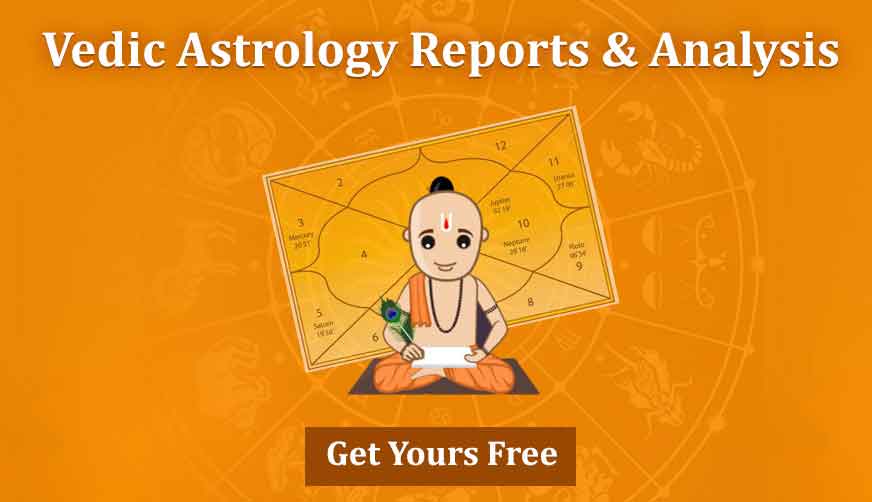Parts of Panchang
Panchang or Hindu calender is based on five factors as follows:
- Karana
- Nakshatra
- Yoga
- Tithi
- Day
Karana
Two Karanas make one Tithi. Purvardha or the first half of the Tithi has one Karana and Uttrardh or the second half of the Tithi has another Karana. A difference of 6º between Sun and Moon forms one Karana. Total number of Karanas is 11 and are divided into two parts.
1. Char Karana
1. Bav 2. Balav 3. Kaulav 4. Taitil 5. Gar 6. Vanij 6. Vishti
2. Sthir Karana
8. Shakuni 9. Chatushpada 10. Naga 11. Kistughana
Nakshatras
There are a total of 27 Nakshatras in Vedic astrology. If an angle of 360º is divided into 27 parts, then each part will be of 13º 20'. Generally, one Nakshatra remains for 24 hours, but sometimes it may take less or more time to cover 13º20'. Time taken by Moon to cover 13º 20' is called one Nakshatra. One Moon sign has 2 and a quarter Nakshatras.
Each Nakshatra is divided into four phases. Among the 27 Nakshatras, 6 Nakshatras are known as Gandmoola Nakshatras. 27 Nakshatras are divided among 9 planets and hence, each planet has the lordship of the 3 Nakshatras.
Results as per Nakshatra group of each planet are as follows:
Results of Nakshatras of Sun: Kritika, Uttarafalguni and Uttarashadha
A person born in this Nakshatra has high self-esteem and good health. He is ambitious and wealthy. He will get benefits from government.
Results of Nakshatras of Moon: Rohini, Hast and Shravan
A person born in one of the Nakshatras of Moon will be playful, happy and cool in nature. He likes traveling and he will be a good planner.
Results of Nakshatras of Mars: Mrigshira, Chitra and Ghnaishtha
A person of this Nakshatra will be determined, brave, angry and egoistic in nature. He will enjoy good financial status.
Results of Nakshatras of Mercury: Ashlesha, Jyeshtha and Revathi
A person born in one of the Nakshatras of Mercury will be intelligent, educated, professional and soft spoken but he will be selfish in nature.
Results of Nakshatras of Jupiter: Punarvasu, Vishakha and Bhadrapada
A person born in the Nakshatras of Jupiter will be serious and soft-spoken in nature. He will be highly educated and rich. He will achieve fame through religious and social activities. He will be honored by the government.
Results of Nakshatras of Venus: Bharni, Purvafalguni and Purvashadha
A person born in one of the Nakshatras of Venus will be music and art lover. He will be rich and enjoy worldly pleasures. He will have fun-loving nature.
Results of Nakshatra of Saturn: Pushya, Anuradha and Uttarabhadrapada
A person born in one of the Nakshatras of Saturn will be hard working, mysterious and just. He may struggle a lot in life. He likes to serve others.
Results of Nakshatras of Rahu: Adra, Swati and Shatbhisha
A person born in this Nakshatra may be clever, brave and religious. He will have all the qualities of politicians. He will win over his enemies and he always wishes to achieve fame.
Results of Nakshatras of Ketu: Ashwini, Magha and Moola
A person born in this Nakshatra may be clever, courageous, and spiritual. He will win over his enemies.
Yoga
A difference of 13º 20' in the speed of Sun and Moon creates one yoga. There are total 27 yogas in Vedic astrology. These yogas are not related to the position of space. Generally, these yogas are used to consider Muhurutha for traveling and other auspicious events.
- Vishkumbh
- Preeti
- Ayushman
- Saubhagya
- Shobhan
- Atigand
- Sukarma
- Ghriti
- Shoola
- Gand
- Vridhi
- Dhruv
- Vyaghat
- Harshan
- Vajra
- Sidhhi
- Vyatipat
- Variyan
- Paridh
- Shiva
- Sidhha
- Sadhya
- Shubh
- Shukla
- Brahma
- Indra
- Vaidhriti
Tithi
Moon month has 30 Tithis (dates), in which 15 Tithis come under bright half and another 15 Tithis come under dark half. They are as follows:
- Pratipada
- Second Tithi
- Third Tithi
- fourth Tithi
- fifth Tithi
- Sixth tithi
- Seventh Tithi
- Eighth Tithi
- Ninth Tithi
- Tenth Tithi
- Eleventh Tithi
- Twelfth Tithi
- Thirteenth Tithi
- Fourteenth Tithi
- Full moon day
- No moon day
Tithis are counted from Pratipada of bright half. Full moon day is the 15th Tithi and no Moon day is the 30th Tithi of Moon month. The day when Sun and Moon are placed at the distance of 180º, means when Sun and Moon are opposite to each other will be the full Moon day. When Sun and Moon are placed at a distance of 0º then the day will be the no Moon day.
Total angle is of 360º. To calculate one Tithi,
one Tithi= 360/30 = 12. Therefore, one Tithi forms when Sun and Moon cover a difference of 12º.
For example, Pratipada occurs between 0º to 12º, second Tithi occurs between 12º to 24º and no moon day occurs between 330º to 360º. As per Vedic astrology, sometimes Tithi is increased by one day and sometimes Tithi is reduced by one day. Tithi in which Sun rises twice will be known as an increased Tithi and in which Sun does not rise even once will be known as the reduced Tithi.
For example, Tithi starts from Sun rise and will remain for 2 hours after next Sun rise. This Tithi touches the second Tithi. Therefore, this is an increased Tithi. Similarly, there is another Tithi which begins after Sun rise and gets finished before next Sun rise. This tithi does not touch the second tithi and will be known as the reduced Tithi.


